
These are products that I
personally use and reflect my own personal experiences.
|
Equipment Reviews |
|
>>>>
Incubator and Brooder Tools <<<<
>>>>
Poultry Feeders
<<<<
>>>>
Poultry Drinkers <<<<
>>>>
Fencing & Netting <<<<
|
|
Checktemp®
1 Digital Thermometer
Hanna Instruments |
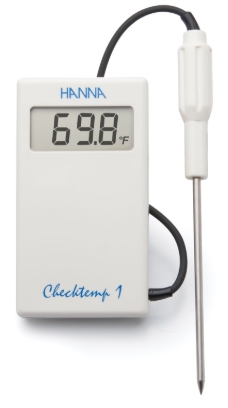 |
APPLICATION:
Monitor/check temperature inside an incubator or hatcher. |
| DISCUSSION: |
|
Over the years, I have purchased and used a number of digital
thermometers. None proved reliable for incubation purposes. Many were
inaccurate or unreliable. Several responded too slow or too
quickly. Few could be calibrated. Even the Brinsea Spot Check
had problems: accuracy couldn't be checked in an ice water bath,
the reading bounced all over, and the batteries didn't last.
Eventually, they all found their way into the junk draw never to
be seen again. Criteria:
- Accurate: Accurate to ±0.5°F and readable to 0.1°F
- Verifiable: Ability to check accuracy in an ice water
bath
- Readable: Numbers large enough to be easily seen
- Response: Responds well to changes without persistent
bouncing
- Size: Small enough to to interfere with the incubator's
air flow
- Flexible: able to read temperatures at various locations
- Portable: able to be moved from one incubator to another
|
REVIEW:
 |
Overall, the Checktemp® 1 Digital Thermometer is the best
relatively inexpensive digital thermometer that I have discovered
thus far. I have found it very useful in spot checking temperatures
in locations where my 8" glass thermometers cannot fit. While I
don't imagine that I will abandon the use of my handy-dandy, trusted
glass thermometers, the Checktemp has proven useful and should find
a permanet place in my box of tools.
- Accuracy: The unit
cannot be calibrated. However, it is suppose to be self
calibrating and reads down to 32°F. Thus far, it has
consistently read 32.0°F when submerged in a settled icewater
bath. At this point, I am confident that it is reading accurately.
- Verifiable: The probe can be submerged in liquid and
accuracy can be checked with an icewater bath.
- Readable: The numbers are easily viewable especially
since the monitor stays on the outside of the incubator and can
be held in hand.
- Response: The readout does not bounce around but
remains stable. The reading does drop rapidly when the incubator
is opened indicating that it rapidly responds to temperature
changes.
- Size: The 6" probe permits placement in a variety of
locations without interfering with the air flow.
- Flexible: The 6" probe can easily penetrate the side
of a desktop incubator so the temperature can be checked in a
variety of locations. Removal of the probe leaves a very small
hole that should have a minimal impact of heat retention. In my
cabinet incubators, I drilled small holes in locations that
required checking. If desired, the small holes can be covered
with a small piece of tape. With a 3.3' cable, the probe can
also be moved around inside the incubator to measure areas that
the probe cannot reach.
- Portable: When the probe is used to penetrate the
sides of the incubator, the unit can be moved from incubator to
incubator. Since the probe is stainless steel, it can be wiped
with an disinfectant wipe to reduce chances of
cross-contamination. Being battery operated, the unit is not
tethered to the length of a power cord.
|
| NEGATIVE POINTS: |
- The unit is not rechargeable
- The temperature probe cable cannot be disconnected from the
unit
- The probe wand is large and cannot easily fit through
existing small holes.
- The battery cover must be removed using a small Phillips
screw driver in order to alter settings such as °C/°F selection
or auto-off timing.
|
| KEY FEATURES: |
- 6 inch stainless steel probe
- 3.3 foot cable
- Reads to 0.1°F
- Accurate to ±0.5°F
- Temperature range of -58.0 to 302.0°F
|
| SPECIFICATIONS:
(from the
manufacturer) |
- ±0.2°C (±0.5°F) - Accuracy
- Most accurate temperature tester in the world
- CAL Check™ - Automatically verifies calibration at startup
- Silicone probe cable - 3.3’ silicone cable maintains
flexibility and performance
- °C/°F Status – User selectable
- Large display with wide environmental temperature range and
viewing angle.
- IP 65 water resistant protection
- HACCP Compatible - Use as a tool for control in HACCP
analysis
- AISI 316 stainless steel penetration Probe
- Auto-Off (select from 8 min., 60 min., or turn the feature
off)
|
| |
PRICE & SOURCE: |
| |
- $39.00 + Free Shipping
- saltwateraquarium.com
- https://www.saltwateraquarium.com/checktemp-1-digital-thermometer-hi98509-hanna-instruments/
|
|
CALIBRATING
THERMOMETERS |
|
Freezing Point |
Boiling Point |
- Fill a glass with crushed ice cubes and cold water.
- Stir the water and let sit for 3 minutes.
- Stir again, be sure there is at least 4" thick layer
of ice.
- Insert your thermometer into the glass, making sure
not to touch the sides.
- The temperature should read 32°F (0°C).
- If it doesn’t, loosen the glue holding the glass to
the scale, move the glass up or down as needed.
- Recheck
|
- Boil a pot of distilled water.
- Once the water has reached a rolling boil, insert
your thermometer, making sure not to touch the sides or
bottom of the pot.
- The temperature should read 212°F (100°C).
- If it doesn’t, loosen the glue holding the glass to
the scale, move the glass up or down as needed.
- Recheck
|
|
Analog
Dial Hygrometer
Western Humidor |
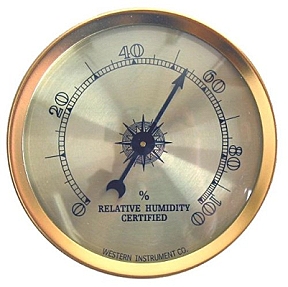 |
APPLICATION: Monitor/check
humidity inside an incubator or hatcher. |
| DISCUSSION: |
| The most accurate means of measuring humidity inside an
incubator is the wet/dry bulb method; however, such a system is
bulky and prone to human error. It's simply not very practical in
most hobby situations. Alternative, inexpensive digital hygrometers
are simple to use, easy to read, and compact in size. Unfortunately,
most are horribly inaccurate and cannot be calibrated. The best
alternative that I've found is the analogue, dial hygrometer... one
that can easily be calibrated when accuracy is in doubt.
Criteria:
- Calibration: Must be capable of being calibrated
- Accurate: Must be fairly accurate
- Reliable: Infrequent calibration required
- Readable: Must be easy to read
- Portable: Capable of being used in a variety of
settings
|
REVIEW:
 |
Overall, the Western Humidor Analog Dial Hygrometer fulfills my
needs for an incubation hygrometer. I'm able to place it in my
cabinets to double check the accuracy of their digital gauges and
use them in my homemade incubators and hatchers to monitor humidity
levels. I've not felt the need to use a different hygrometer since
their original purchase.
- Calibration: Calibration is achieved by adjusting a
small set screw in the back of the device. Once adjusted,
rechecking and readjusting may be necessary before finalizing
calibration.
- Accurate: The manufacturer claims that the device is
accurate within ±1%. I've not had cause to doubt this claim.
- Reliable: The devices were check using the salt
method. These days, I check the reading once a year as
recalibration is rarely necessary.
- Readable: While not as easy to read as a digital
hygrometer, the dial is large enough to view the reading even
from a small distance.
- Portable: The outside of the device is easy to wipe
down with a disinfectant wipe allowing it to be moved from
incubator to incubator with minimal concern.
|
| NEGATIVE POINTS: |
- Requires a very small screwdriver to adjust
- Not as accurate as a wet/dry bulb system
- May impede airflow without careful placement
- No historical recordings of humidity levels over time
|
| KEY FEATURES: |
- Large, easy to read dial
- Does not require frequent calibration
- Easy to calibrate
- Can be moved to different units
- Easy to clean
|
| SPECIFICATIONS:
(from the
manufacturer) |
- Advanced humidity sensor maintains accuracy to +/- 1%
- User recalibrate-able
- Scratch & fog resistant glass face
- Aluminum case resists corrosion
- Secure magnetic mount
|
| |
PRICE & SOURCE: |
| |
|
|
CALIBRATING
HYGROMETERS |
|
Towel Method
(Less Accurate) |
Salt Method
(Most Accurate) |
- Dampen a towel (not dripping wet, but good and damp), then wrap the hygrometer in the towel for 30 to 45 minutes.
- Then unwrap it and read the humidity (quickly). If your hygrometer is perfectly calibrated (few are) it will be reading exactly 100% humidity. Most likely, it will be reading somewhere between 80 and 90%.
- At this point, whatever the hygrometer reads, you can either set the needle to exactly 100% immediately after the test, or if you're a little lazier, make a mental note of how far over or under the actual humidity is from the reading from your hygrometer.
|
- Place a teaspoon of salt in a bottle cap or small cup and dampen it with a few drops of water (without dissolving it).
- Carefully place the wet salt and the hygrometer inside a see-through container and close tightly. You can use a zip lock bag provided it seals well and you leave some air inside as well.
- Let it sit for at least 6 hours and note the reading on the hygrometer without opening the container. The hygrometer should should read 75%. The difference is how much your hygrometer is off. For example, if your hygrometer reads 70% during the salt method test this means that to obtain the real humidity level you should add 5 points.
- If you have an analog hygrometer, you can correct the reading. You will need to adjust the needle to the 75% mark by turning the screw on the back using a small screwdriver. Your hygrometer is now ready to be placed inside your humidor.
|
|
Digital Temperature Controller
Docooler & Inkbird |
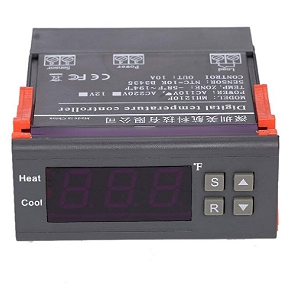 |
APPLICATION: Monitor and
control temperature inside a brooder. |
|
DISCUSSION: |
|
Baby chicks require a specific temperature according to their age.
Traditionally, heat lamps have been used with the raising and lower
of the lamp controlling the temperature at floor level.
Unfortunately, this method is unreliable: heat can build up in the
shavings causing them to over heat, heat lamps can be bumped causing
to fall possibly causing fire, and the system requires too many
manual adjustments.
A temperature controller resolves many of these issues by
eliminating any guesswork. The heat source is permanently mounted in
the brooder and the controller is programmed for the desired
temperature.
Criteria:
- Cost: relatively inexpensive
- Precision: adjustable to 1°F
- Accurate: accurate to 1°F and verifiable
- Flexibility: allow for flexible installation
- Reliable: turn on and off at the desired
temperature
- Load: able to handle desired heat source
- Power Loss: remember settings on power loss
|
REVIEW:
 |
Overall, the Decooler and Inkbird digital temperature controllers have proven
invaluable in regulating the temperature inside brooders and
grow-out pens. Despite poor instruction, the device is fairly easy
to wire directly or into an extension cord. Those without a basic
understanding of electrical wiring will need the assistance of
someone with experience.
- Cost: Since, the heat source need not stay on 24
hours daily, costs are easily recoverable through power savings.
- Precision: The device can be adjusted to at least 1.0°F
with older devices capable of adjusting to 0.1°F.
- Accurate: Although accuracy is not a major concern,
the device can be checked using an ice water bath and adjusted
accordingly. Adjustments have not been necessary in my
applications.
- Flexibility: I currently have 8 brooders and 4
grow-out pens using temperature controllers. This device has
been used in both permanent installations using hardwiring and
portable applications using power cords.
- Reliable: In 98% of all instances, the device
has proven reliable in accurately turning on and shutting down
the heat source; however, in a few
instances where the heat source has been on for an extended
period of time (>24 hours) the device has failed to shut off the
heat source. This device should NOT be used in
critical applications such as an incubator or hatcher.
- Load: See Reliable note above.
- Power Loss: These device remembers the settings after
a power loss.
WARNING:
This device is unsuitable for monitoring and/or controlling
temperature inside an incubator or hatcher. The devices lacks the
necessary accuracy and can fail to shut off resulting in
overheating. |
|
NEGATIVE POINTS: |
- Direct wiring only requiring some electrical skills
- Instructions can be difficult to follow
- Contact points are small and rather fragile
- Shut off failure can be a significant problem if the device
is overloaded or if the circuit remains on for an extended
period of time
|
|
KEY FEATURES: |
- Inexpensive: $14.99-$15.99
- Large and clear LED display for readability
- Settings easy to adjust
- Reads to 32°F, can be calibrated
- Direct wiring, flexible installation settings
- Remembers settings on loss of power
|
|
SPECIFICATIONS:
(from the
Decooler; Inkbird will be slightly different) |
- Working voltage: 110V ±10%
- Rated current: 10A
power consumption: 3W
- Measurement range: -58~194 F
- Measurement precision: 0.1 F
- Measurement error: ±1 F
- Control range: -58~194 F
- Control precision: 1 F
- Temperature sensor: NTC 77
- Item size: 3.4*3*1.4in
- Item weight: 5.6oz
|
| |
PRICE & SOURCE: |
| |
|
Digital Temperature Controller
WillHi |
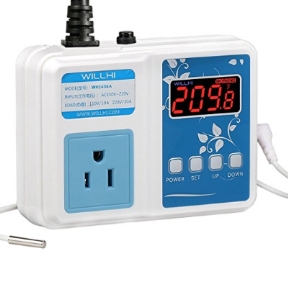 |
APPLICATION: Monitor and
control temperature inside brooders/incubators. |
|
DISCUSSION: |
|
Baby chicks require a specific temperature according to their age.
Traditionally, heat lamps have been used with the raising and lower
of the lamp controlling the temperature at floor level.
Unfortunately, this method is unreliable: heat can build up in the
shavings causing them to over heat, heat lamps can be bumped causing
to fall possibly causing fire, and the system requires too many
manual adjustments.
A temperature controller resolves many of these issues by
eliminating any guesswork. The heat source is permanently mounted in
the brooder and the controller is programmed for the desired
temperature.
Criteria:
- Cost: relatively inexpensive
- Precision: adjustable to 1°F
- Accurate: accurate to 1°F and verifiable
- Flexibility: allow for flexible installation
- Reliable: turn on and off at the desired
temperature
- Load: able to handle desired heat source
- Power Loss: remember settings on power loss
|
REVIEW:
 |
|
I use four WILLHI thermostats in my brooders/grow-up pens and one in
my homemade incubator. The newer ones are a little more complex to
configure as they have a greater range of options; however, they are
not difficult to set with a little tinkering. Accuracy has been
tested using an icewater bath and none have yet required
adjustments. The WILLHIs have performed flawlessly thus far. This
device is a satisfactory replacement for more expensive homemade
incubator and hatcher thermostats. A secondary thermostat, such as a
wafer assembly, is highly recommended.
- Cost: Yes, under $30.
- Precision: Yes, adjustable to 0.1°F.
- Accurate: Fairly accurate to 1°F and verifiable.
- Flexibility: Yes, temperature probe of nearly 10
feet.
- Reliable: Yes, no fault experienced to date.
- Load: Yes, loads up to 1100 watts.
- Power Loss: Yes, it remember settings on power loss
|
|
NEGATIVE POINTS: |
- The multitude of settings may make configuration somewhat
confusing.
- Instruction manual is sufficient but does not explain in
detail all settings.
- Small mounting ports and screws
|
|
KEY FEATURES: |
- Detachable temperature probe.
- No hard wiring required (Plug-n-Play)
- Can be calibrated (Reads down to 32°F)
- 0.1°F resolution (Readable to the 1/10°F)
- 0.1°F slew range (Turn on at 99.4°F and Off at 99.5°F)
- Long, waterproof probe (Flexibility)
|
|
SPECIFICATIONS:
(from the
manufacturer) |
- Power supply: AC 110V ~ 240V, 50/60Hz
- Measure range: -4 ~ 220 F(-20 ~ 105 C)
- Temperature resolution: 0.1°F
- Accuracy: ±0.5
- Slew range of temp controlling: 0.1 - 25°F
- Control resolution: 0.1°F
- Relay contact capacity: 8A
- Store setting after power off: YES
- Compressor delay protection: YES
- High and Low Temperature alarm: Yes
- Sensor Cable length: 3m (9.8ft)
- Switch temperature unit (Default: F): F or C
- Switch resolution (Default:0.1): 0.1° or 1°
- Auto shut off timer (Default:OFF)
|
| |
PRICE & SOURCE: |
| |
|
Satco 175 Watt IR Heat Lamp
Satco |
 |
APPLICATION: Heating
source for brooders and grow-up pens. |
|
DISCUSSION: |
|
New hatchlings require warmth... 95.0°F the first week with a
gradual drop of 5.0°F each subsequent week. Traditional, 250 watts
infra-red bulbs can be problematic, they produce too much heat for a
small space, burn out relative quickly, and are prime candidates for
starting fires. To address these issues, many hobbyists have turned
to heat plates such as the Brinsea EcoGlow. However, heat plates
present their own problems: they are expensive, limits the number of
chicks per brooder, requires constant height adjustment, and can be
problematic to keep clean.
Criteria:
- Cost Efficient
- Safe
- Effective
- Easy of Use
|
REVIEW:
 |
|
The Satco S4751, 175 Watt, IR Heat Lamp is my preferred method of
providing heat in my brooders and grow-up pens. Lamp fixtures are
permanently installed or secured with safety cables and are
controlled by temperature controllers (see Decoolor and InkBird
reviews). The heat produced is sufficient but less severe than
that produced by 250 watt bulbs reducing heat stress and pasty butt.
- Cost Efficient: $4.54 per bulb compared to ~$9.00 for
a 250 watt bulb and the Satco S4751 tends to last 2-3 times
longer.
- Safe: I've never had a Satco S4751 shatter even when
used in a waterfowl brooder where water splatter is common. I
have experience a few instances of base/bulb separation but at a
rate on only 1/10th that of a traditional 250 watt lamp.
- Effective: Very effective within a confined brooder,
less so in an unconfined space such as a 6'x10' grow-out pen
during very cold weather.
- Easy of Use: When used with a ceramic lamp socket,
heat shroud, safety cables, and temperature controllers on
properly rated extension cords, the lamp can be used in a wide
array of situations.
|
|
NEGATIVE POINTS: |
- Requires careful installation to prevent fires
- Best used with a temperature controller
- Must periodically remove dust and dander from bulb flare
|
|
KEY FEATURES: |
- Less expensive than 250 watt red heat lamps
- Shatter resistant
- 175 watts provides sufficient heat for enclosed brooder
- 175 watts less likely to overheat brooder
- Lasts longer than traditional infra red bulbs
|
|
SPECIFICATIONS:
(from the
manufacturer) |
- BR38 infrared heat lamp
- Operates at 175 watts and 120 volts.
- Just over 5 inches in length with a 4.75-inch diameter
- Medium (E26) base
- Rated to last an average of 5,000 hours.
|
| |
PRICE & SOURCE: |
| |
The Premier 1 Supplies, "Never-loose" Base pressed glass lamps
are preferred over the Satco S4751; however, shipping costs often
makes them significantly more expensive.
|
Ceramic Heating Lamp
Various Manufacturers |
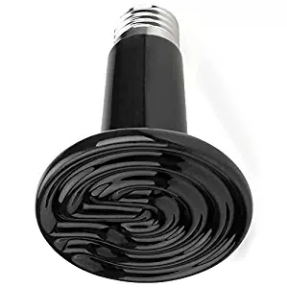 |
APPLICATION: Heating
source for brooders and grow-up pens. |
|
DISCUSSION: |
Advantages:
• Safer: bulb is unlikely to shatter although it will break if
dropped
• Lack of light emission prevents disruption of sleeping cycles
• Comes in a wide variety of wattages
• Relatively long lastingDisadvantages:
• Heat travels straight up; fails to heat brooder floor unless hung very low
• When used with a temperature controller, the Off/On cycles causes the
lamp to become loose and fail to produce heat.
• Can only determine if lamp is working by touch
• Suitable for only a small amount of chicks within a very confined space
|
|
PRODUCT IS NOT
RECOMMENDED
Product is not a true Infrared heat lamp. Infrared heat is produced
when infrared light rays bounce off a surface... commonly the
brooder floor. With these lamps, no such rays are produced and the
heat generated flows up from the bulb. The brooder floor is not
heated unless the lamp is set very low in the brooder |
LED Light Egg Candler
HBlife |
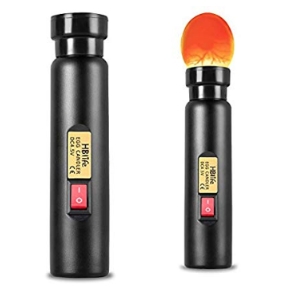 |
APPLICATION:
Candling hatching eggs. |
| DISCUSSION: |
|
My first candling device coffee can with a
hole cut in one end and an incandescent light bulb serving as a
light source... it worked but on a limited basis. Over the
years, I've used a variety of devices ranging from a light in a
shoe box to cheap LED lights from the Dollar store, to more
expensive flashlights. Incandescent bulbs tend to grow hot and
care must be taken to avoid cooking the eggs. Traditional
flashlights perform well but escaping light obscures the view.
Bright flashlights are expensive with many cheaper flashlights
having less than desirable lumen output.
A candler need not be expensive or fancy. It simply needs to
allow us to view inside the egg.
CAUTION: Flashlight makers
tend to wildly exaggerate the brightness of their flashlights.
One tactical flashlight boasts a 1,000 lumen output but has less
than 1/4 the output of this 220-240 lumen device. Advertisements
are simply not reliable.
Criteria:
- Brightness: bright enough to illuminate egg
interior
- Avoid Heat: not produce heat greater than 100 °F
- Stray Light: block the escape of light between
the candler and egg
- Reliable: not dim over time or require frequent
lamp replacement
|
REVIEW:
 |
Overall, HBLife performs well and allow easy viewing inside all of
my eggs including my darker Easter Egger and turkey eggs. It is
superior to any of the other devices that I have used. Cord length
does limit viewing to the length of the cord; however, my experience
with inexpensive rechargeable battery devices makes a corded device
desirable.
- Brightness: 50% brighter than the Pilot Electronics Powerbank/Flashlight
that I had been using. The Pilot flashlight had performed
admirably.
- Heat: None noted.
- Stray Light: The soft cups are not 100% effective but
gentle pressure eliminates virtually all stray light.
- Reliable: No notable problem as of this writing.
|
| NEGATIVE POINTS: |
- The unit does not use a rechargeable battery.
- Cord limits candling to a single area
- Appears/feels flimsy/cheap but does not affect operation
|
| KEY FEATURES: |
-
Two soft rubber covers fits large duck eggs to tiny quail eggs
-
Cool LED light source, no heat from lamp
- Fits comfortably in the hand
- Large on/off switch
- No batteries to replace
|
| SPECIFICATIONS:
(from the
manufacturer) |
- Powered by power cord only
~ 4 feet
- Product Dimensions: 5.9 x 1.38 x 1.38 inch
- Output (Luminous Flux): 220-240 Lumens
- Power Supply: 100-240 V
- 100% money back guarantee
|
| |
PRICE & SOURCE: |
| |
|
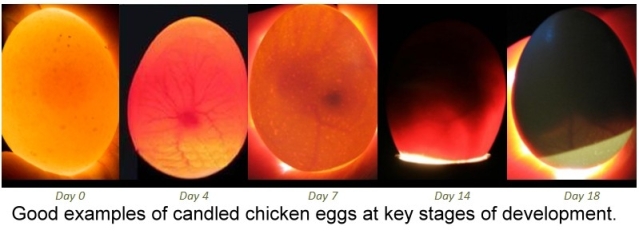 |
Incuview
Incubator Warehouse |
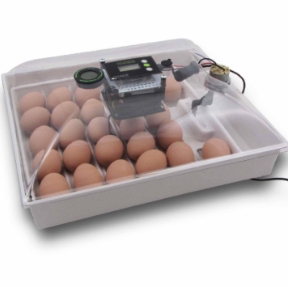 |
APPLICATION: Egg Incubator |
|
DISCUSSION: |
|
Incubators are relatively expensive, especially Brinsea.
Unfortunately, I can't afford to buy one of every type just to test
them and see how they do. Incubator Warehouse is a vendor that I use
frequently and they sent one of their IncuView for testing. With its
clear-top dome and unique egg turner, I thought it might be a
suitable replacement for the more expensive Brinsea tabletops. Criteria:
- Quality
- Adequate Turning
- Adequate Ventilation Ports
- Stable Humidity
- Minimal Temperature Variations
- Minimal Warm/Cool Spots
- Simple Instructions
- Reliability
|
REVIEW:
 |
|
Unfortunately, the IncuView did not live up to my hopes. While
Incubator Warehouse clearly spent time and thought into design and
construction, it failed to demonstrate adequate stability and
reliability.
- Quality: Yes, the plastic initially looked flimsy and caused concerns about durability. However, upon physically handling the top and bottom those initial concerns dissipated. The plastic is stiff enough not to “flop around” but flexible enough that it should not crack if it encounters a shock such as being dropped. When assembling the unit, I accidentally drop the power plug on the cover and immediately thought, “Did I break it?” But the plug bounced off the flexible plastic causing no damage or scratches.
- Adequate Turning: Yes, a standard size chicken egg will generally turn more or less 90° during a single rotation. In most instances, a cumulative effect will result in eggs turning 180° within a 24 hour period. Although eggs do not stay perfectly aligned within their row, they do not appear to bunch, jam, or get stuck in a single position. It is assumed that larger eggs would experience a smaller degree of rolling and smaller eggs a larger degree though such assumption will need to be physically tested.
Comparatively, other desktop turners would receive a rating of 4 or 5
stars. If the unit had the capability of one rotation per hour, a
5 star rating would be appropriate.
- Adequate Ventilation Ports: The unit contains one
ventilation port in the top portion of the cover. There are not
holes in the bottom of the unit and there is a concern that
there might be a problem at hatch time especially if the
optional automatic humidity is attached through the single port
at the top. A "Evaporation Test" was conducted to determine if
there was sufficient airflow through the unit. The test
demonstrated that there likely was. However, I would probably
drill a couple of very small holes in the bottom tray for my own
piece of mind.
- Stable Humidity: Yes, the digital hydrometer was
tested using the salt test and reflected the appropriate
reading. The water trays are fairly easy to access and fill and
resulted in a stable humidity reading. Humidity is controlled by
the number of channels in the bottom containing water. This
system is adequate for incubation needs. Because the humidity
ran at 17% with no water present, dry incubation is not
recommended for this unit.
- Minimal Temperature Variations:
No. For best results, there should not be a
temperature variation of greater than ±0.5°F. During testing,
the temperature bounced between 98.3°F and 100.5°F on the
separate, calibrated thermometer. The Control Panel did not
reflect these variations. Attempts were made to reduce
this variation including proper incubator placement, closing off
the ventilation port, wrapping the base in a towel, and checking
room temperature variation. The variations continued. With eggs
present, variations continued at a ±2.0°F flux and these
variations were reflected in the Control Module.
- Minimal Warm/Cool Spots: No.
Various area of this unit was tested for warm and cool spots,
empty and with eggs present. Without eggs present, there was a
minor difference among some areas with the high of 99.7°F and
low of 99.2°F for a variance of 0.5°F. Unfortunately, this
variance grew with eggs present with a high of 100.8°F and a low
of 98.7°F for a variance of 2.1°F. Since not all areas were
monitored at the exact same time, the variance might have been
the result of overall temperature variation rather than simple
warm/cool spot variances.
- Simple Instructions: Yes, overall the instructions
were simple but relatively complete. Actually, the best that
I've seen with a hobbyist incubator.
- Reliability: No.
the unit failed on Day 16 of the first batch... the heating
element would not shut off when the desired temperature was
reach. Temperature rose to +102°F. Attempts were made to correct
the issue by contacting Incubator Warehouse and following their
instructions. The problem was not resolved. The test was
discontinued with the unit taken off-line. Two weeks later, a
second attempt was made to resolve the issue. Attempts failed.
Unit was returned to Incubator Warehouse, and their testing
could not identify a defect in the unit.
PRODUCT IS NOT
RECOMMENDED
At
this time, I do not feel comfortable with any low-end incubator with
digital controls and would recommend only purchasing a desktop unit
with an old fashion wafer style thermostat. The digital controls
just do not seem reliable enough for incubation. |
|
NEGATIVE POINTS: |
- Wide temperature swings: 98.3°F-100.5°F.
- Significant differences in temperature in different
locations.
- Adequate ventilation is questionable.
- Unit
failed before the first test batch was complete.
|
|
KEY FEATURES: |
- Incubator Warehouse Incubator Control Module™
- Pre-set proportional digital thermostat (99.5 F)
- Digital display of temperature
- Automatic temperature control in °F or °C
- Hatch Timer
Control number of egg turns per day
- Built-in humidity gauge
Automatic universal egg turner (Any size egg up to Goose)
- Egg Capacity: 27 chicken*, 49 Quail*, or 17 Goose*
- Durable plastic construction
- Transparent dome for easy viewing
- Easy-to-fill humidity rings
- 12V DC power (Allows 110V OR 220V Input)
|
|
SPECIFICATIONS:
(from the
manufacturer) |
- Dimensions: 12" x 14" x 6"
- Material: Plastic
- Circulated Air: Yes
- Style: Tabletop All-In-One
- Thermostat Type: Digital Electronic
- Voltage: All (12V DC, through 240V AC)
- Watts: 40
|
| |
PRICE & SOURCE: |
| |
|
410 Watt Power Converter
Schumacher Electric |
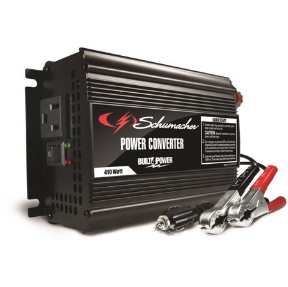 |
APPLICATION:
Backup power for incubators |
| DISCUSSION: |
|
At times, I can easily have $1,500.00 worth of eggs
incubating at one time. Extended power outages can be a
financial disaster. A generator can be prohibitively expensive
and startup cumbersome. Sometimes something small and simple
works best. Criteria:
- Relatively inexpensive
- Easy to use
- Reliable
|
REVIEW:
 |
I've used this device to power three cabinets and one tabletop at a
time... in one instance for 16 hours straight. The device simply
worked. For startup, I plugged in a one device, at a time
allowing that device to come to temperature before plugging in the
next device.
- Relatively inexpensive: Yes, less than $30.00.
- Easy to use: Yes, relatively speaking. I hooked the
device straight to the battery using the clamps, ran the
extension cord through a partially open window, and connected
the incubators one at a time.
- Reliable: The unit is able to power at least three
cabinets and one tabletop without over-stressing, over-heating
the device, or draining the automotive battery. I did run the
truck for 15 minutes every 4 hours to avoid draining the truck
battery.
|
| NEGATIVE POINTS: |
- Requires a good automotive battery
- Requires running an extension cord outdoors usually during
bad weather
- Requires running vehicle for about 15 minutes every 4 hours
- Some reports of damage to sensitive electronic devices due
to difference between converted power and normal AC power
- Limited wattage. Not able to run devices that consumes large
amps such as saws, drills, etc.
|
| KEY FEATURES: |
- Expedient source of AC power during power outages
- Limited drain on automotive battery
- Plugs in to vehicle 12V accessory outlet or connects
directly to battery with included clamps
|
| SPECIFICATIONS:
(from the
manufacturer) |
- 410W of continuous power with 820W peak
- Converts vehicle power to household power
- 2-amp USB port for portable electronic devices
- Two 120V AC outlets
- High-speed cooling fan
- Surge protection
- Low battery alarm
- Thermal protection: unit will shut down if safe operating temperature is exceeded
- On/off switch with LED indicator
|
| PRICE & SOURCE: |
| |
|
Saturn Yellow Feeder
Premier 1 Supplies |
 |
APPLICATION:
Juvenile and adult poultry feeder. |
| DISCUSSION: |
|
Like people, chickens have food preferences and will search
through their feed to find the most desirable morsels. The act
of of pecking through the feed often results in waste as birds
knock feed out of the feeder and onto the ground. This does not
present a sizable problem with pellets b°F°Fec°F°Fause the birds can
simple eat the pellets off the ground; however, moisture often
result in mold with crumbles. I've tried a number of different
feeder types including those with a grill. None adequately
resolved the problem.
Criteria:
- Reduces feed waste
- Washable
- Easily refillable
- Durable
|
REVIEW:
 |
Overall,
the Saturn feeder is the only feeder that I will use in my grow-up
pens inside the barns. For adults in outdoor pens, I use 50 lb
feeders made from plywood.
- Reduces feed waste: Yes, not 100% effective but close
- Washable: Yes, parts can be separated for washing
- Easily refillable: Yes, with rain hat removed
- Durable: Over the 8 purchased over the past several
years, seven are still in use. The hanging loop in one is broken
requiring it to sit on a stand instead of being hung.
NOTES:
- To ease refilling, do not use rain hat when hanging feeder
- To discourage roosting, use the rain hat when the feeder is
not hung
|
| NEGATIVE POINTS: |
- Shipping is rather expensive unless the total purchase is
more than $100
- Plastic can become brittle when left in the sun
- Too much force can break plastic components
- Can be difficult to separate supper and lower portions
- Despite being labeled for outdoor use, the small rain hat
does not adequately cover the feeder and moisture will ruin the
feed
|
| KEY FEATURES: |
- Easily washable
- Lipped pan reduces waste from birds
from knocking out feed
- Adjustable base design allows for use of crumbles or pellets
- Hanging the feeder just above the bedding to reduce feed
spoilage
- Can be set on a base platform instead of hanging
- Rain hat reduces the instances of birds roosting on the
feeder
|
| SPECIFICATIONS:
(from the
manufacturer) |
- Capacity 15 lb
- Suited for adults
- Number Fed 60
- Dimensions 13"H
16"
- Pan Depth 3"
- Inside/Outside Use
- Hangable
|
| PRICE & SOURCE: |
| |
|
Galvanized Hanging Feeder
Multiple Suppliers |
 |
APPLICATION:
Juvenile and adult poultry feeder. |
| DISCUSSION: |
|
Like people, chickens have food preferences and will search
through their feed to find the most desirable morsels. The act
of of pecking through the feed often results in waste as birds
knock feed out of the feeder and onto the ground. This does not
present a sizable problem with pellets because the birds can
simple eat the pellets off the ground; however, moisture often
result in mold with crumbles. Criteria:
- Reduces feed waste
- Washable
- Easily refillable
- Durable
|
REVIEW:
 |
Overall,
the galvanized hanging feeder is a poor chose in poultry feeders.
- Reduces feed waste:
Problematic: birds easily knock feed out
of feeder
- Washable: Partially, parts can be separated for washing
- Easily refillable: Yes, wide, open top makes
refilling an easy task
- Durable: Problematic, prone to rust.
PRODUCT IS NOT
RECOMMENDED |
| |
NEGATIVE POINTS: |
| |
- Lack of a lip on the feeding tray results in a large amount
of feed knockout
- Powder feed tends to accumulate and pack around the bottom
edge
- Moisture can accumulate along the bottom edge of the tray
resulting in mold
- Cleaning the wire spokes can be difficult
- Metal is prone to rust
|
Plastic Hanging Feeder
Multiple Suppliers |
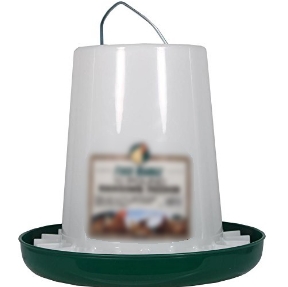 |
APPLICATION:
Juvenile and adult poultry feeder. |
| DISCUSSION: |
|
Like people, chickens have food preferences and will search
through their feed to find the most desirable morsels. The act
of of pecking through the feed often results in waste as birds
knock feed out of the feeder and onto the ground. This does not
present a sizable problem with pellets because the birds can
simple eat the pellets off the ground; however, moisture often
result in mold with crumbles. Criteria:
- Reduces feed waste
- Washable
- Easily refillable
- Durable
|
REVIEW:
 |
- Reduces feed waste:
Problematic, birds can and will easily
knock feed out of the tray using their beaks.
- Washable: Yes
- Easily refillable: Yes
- Durable: Product is no longer in use
PRODUCT IS NOT
RECOMMENDED |
| |
NEGATIVE POINTS: |
| |
- Lack of a lip on the feeding tray results in a large amount
of feed knockout
- Points of tower attachment to base can be difficult to clean
|
Round
Baby Chick Feeder
Harris Farm |
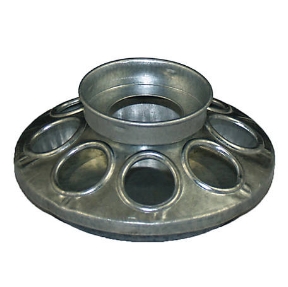 |
APPLICATION:
Feeding chicks, ducklings, and poults. |
| DISCUSSION:
|
|
I hatch around 3,000 hatchlings each year and caring for
hatchlings can be time consuming. A chick feeder needs not only
work but it must allow for the efficient use of time both
filling and cleaning it. Criteria:
- Reduces feed waste
- Washable
- Easily refillable
- Durable
|
REVIEW:
 |
This feeder may be suitable for a very small number of chicks;
however, it does not hold a sufficient quantity to satisfy the needs
of more than 5 or 6 chicks. This feeder can also become top-heavy
and subject to toppling.
- Reduces feed waste: Yes, the lip on the feeder
discourages pecking out crumbles.
- Washable: Problematic.
Most chick feeders can be disassembled, emptied, and wiped
down. The top and bottom portions of this feeder all welded
and cannot be separated making cleaning very difficult
especially when moisture is introduced and powdered feed
becomes compacted along the edges
- Easily refillable:
Problematic. Feeder cannot simply be topped-off.
The bottom portion must be emptied, inverted, and then
screwed onto the 1 quart container. When turned back
upright, a large portion of the feed drops into the
feeder... it takes a good bit of work to make a minimal
amount of feed available.
- Durable: This product is no longer in use.
PRODUCT IS NOT
RECOMMENDED |
| |
PRICE & SOURCE: |
| |
|
Plastic, Flip
Top Chick Feeder
Little Giant |
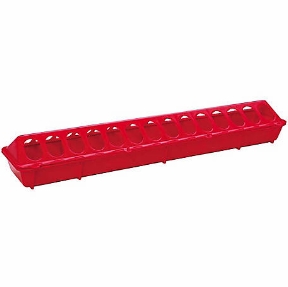 |
APPLICATION:
Feeding chicks, ducklings, and poults. |
| DISCUSSION:
|
|
I hatch around 3,000 hatchlings each year and caring for
hatchlings can be time consuming. A chick feeder needs not only
work but it must allow for the efficient use of time both
filling and cleaning it. Criteria:
- Reduces feed waste
- Washable
- Easily refillable
- Durable
|
REVIEW:
 |
- Reduces feed waste: Yes, the lip on the feeder
discourages pecking out crumbles.
- Washable: Yes, with some effort, the feeder can
be disassembled and washed easily.
- Easily refillable:
Problematic. With metal feeders, the top portion
simply slid to one side, feed is poured into the tray, and
the top slide into place. The top of this feeder opens using
hinges and frequently each of the four front contact points
must be pressed to release the lid... it sometimes takes
some effort to open the feeder. The metal feeders are easier
to use.
- Durable: Excellent, the original two purchased
are still in use.
|
| NEGATIVE POINTS: |
- Large size consumes space in the brooders.
- Opening the feeder for refilling can be difficult.
- Disassembling the feeder for cleaning can be difficult.
|
| KEY FEATURES: |
- Plastic, will not rust
- Plastic, easy to wash
- Large size, holds a good amount of chick starter
|
| SPECIFICATIONS:
(from the
manufacturer) |
- Ground feeder
- Snap-in hinge ensures long life
- Features 28 feeding holes (14 per side) for poultry
- Made of high-density polypropylene
- 20 in. L x 4.5 in. W x 3 in. H
|
| |
PRICE & SOURCE: |
| |
|
Tri-Pod Waterer, 8 gal
Premier 1 Supplies |
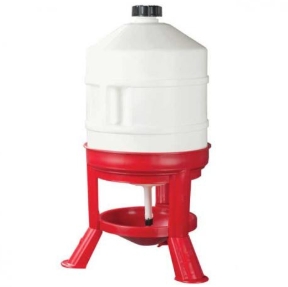 |
APPLICATION:
Watering juveniles and adults. |
| DISCUSSION: |
|
Filling and cleaning poultry waters can be a chore. Keeping
shavings and dirt out of the water pan can also be a challenge.
With poultry waters, I want something that will do the job with
the minimum amount of work. Criteria:
- Large Capacity
- Easy to fill
- Easy to clean
- Durable
|
REVIEW:
 |
Overall, the Tri-Pod 8 gallon water performed well over the years
and was my preferred waterer for juvenile and adult birds. Placing a
4"x4" block of wood next to the water pan allowed smaller birds to
easily reach the water. For small ducklings, the bottom portion was
wrapped in 2"x4" welded wire
- Large Capacity: Yes, 8 gallon capacity, no leakage
once filled
- Easy to fill: Yes, close off the spout by turning the
shut off valve inside the water pan and fill with a garden hose.
There will be leakage from the water pan while filling.
- Easy to clean: Yes, I used my hand to dislodge any
dirt in the water pan during filling. With waterfowl, dirt will
travel up the spout into the tank. Using the water hose to rinse
out this dirt prior to filling was all that is required to keep
the tank reasonably clean. With well water, one capful of
unscented household bleach prevents slim and algae growth.
- Durable: Yes, one container was located in the direct
sunlight and developed a crack in the tank and a hard freeze
caused the water pan in another to crack; however, most are
still in use and have proven more durable than other plastic
waterers.
Significant spillage will occur
while filling this waterer and it should be located
outdoors.
NOTE: While these
waterers are still used in temporary situations, they have
largely been replaced with automatic water bowls attached to
high pressure lines. |
| NEGATIVE POINTS: |
- Plastic can become brittle and crack when left in direct sun
- Dirt from water pan will travel up into tank
- Allowing the water to completely freeze can result in
cracking of water pan
- Small waterfowl will attempt to swim in the water pan
|
| KEY FEATURES: |
- Large capacity
- Easy to fill
- Easy to clean plan
|
| SPECIFICATIONS:
(from the
manufacturer) |
- Capacity: 8 gallon
- Suited for: adults
- Number of birds: 100
- Waterfowl: yes
- Base sits 5.5" above the ground.
|
| |
PRICE & SOURCE: |
| |
|
Poultry
Water Founts
Little Giant |
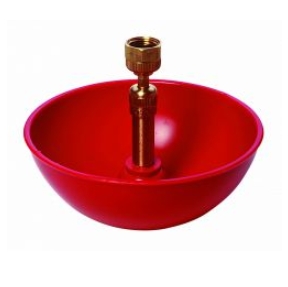 |
APPLICATION:
Watering juveniles and adults. |
| DISCUSSION: |
|
Filling and cleaning poultry waters can be a chore. Keeping
shavings and dirt out of the water pan can also be a challenge.
With poultry waters, I want something that will do the job with
the minimum amount of work. Criteria:
- Large Capacity
- Easy of use
- Easy to clean
- Durable
|
REVIEW:
 |
Currently, seven of these founts are in use, have proven reliable
over the past two years and are a significant time saver.
- Large Capacity: Connected to a high pressure
water line with no need to refill.
- Easy of use: The founts use a tire stem valve,
spring, and brass nuts to adjust and control water levels.
Dirt, debris, and mineral buildup can cause the valves to
become lodged in the open or closed position. Periodically,
the mechanism needs to be disassembled, cleaned, and
adjusted. A valve stem tool is required.
- Easy to clean: Yes, bowls can be removed, wiped
clean with a cloth or hand, and then reattached.
Periodically, the bowls require cleaning and bleaching.
- Durable: All founts continue to be in use.
NOTATION: Significant spillage
can occur
when the valve stem becomes stuck; this waterer should only
be used outdoors. |
| NEGATIVE POINTS: |
- A loose valve stem can cause significant leakage requiring
adjustments
- May require extension of existing high pressure water lines
- Freezing may cause damage to the valve stem requiring
replacement
- Waterfowl will fill the bowl with mud requiring more
frequent cleaning
- Not suitable for indoor use
|
| KEY FEATURES: |
- No need to refill containers
- Relatively easily installed when using a garden hose
- Easy to clean
- Reliable
|
| SPECIFICATIONS:
(from the
manufacturer) |
- Hooks up to any standard half- inch NPT pipe
- Provides a limitless supply of clean water
- Operates between 20 and 50 psi
- Holds 2 pints of water, waters up to 175 birds
- 6.5 Inch in diameter and 2.5 Inch deep
|
| |
PRICE & SOURCE: |
| |
|
3 Gallon Plastic Poultry Drinker
Little Giant |
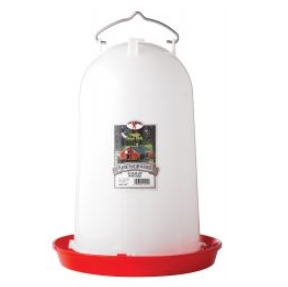 |
APPLICATION:
Waterer for adults and juveniles. |
| DISCUSSION:
|
|
Filling and cleaning poultry waters can be a chore. Keeping
shavings and dirt out of the water pan can also be a challenge.
With poultry waters, I want something that will do the job with
the minimum amount of work. Criteria:
- Large Capacity
- Easy to fill
- Easy to clean
- Durable
|
REVIEW:
 |
I like this waterer and favor it over other similar when used for
juveniles and bantams. It is not suitable for birds with large
single combs -- as rubbing up against the plastic will cause
abrasions. Very nice for indoors as the units do not leak once
filled and flipped.
- Large Capacity: 3 gallon capacity is the perfect
size for my indoor grow-up and breeding pens.
- Easy to fill: Yes, fill the top, place on the
base, and twist to the left. Twisting to the right will
close the opening and water will not flow.
- Easy to clean: Yes, the connection points on the
base and tower can hold dirt that requires special
attention, but otherwise a wipe and rinse is all that is
required.
- Durable: All units purchased are currently in use
with no damage or wear noted.
|
| NEGATIVE POINTS: |
- Not intended for hanging.
- If the base is twisted on in the wrong direction, water
will not flow.
- Narrow trough: Not suitable for adult birds with large
single combs.
- Connection points for top and bottom can be difficult to
clean.
|
| KEY FEATURES: |
- 3-gallon poultry waterer
- Built-in handle for easy portability
- Easy to see the water level
- Red base attracts birds
- Easy to clean
|
| SPECIFICATIONS:
(from the
manufacturer) |
- Product Dimensions 12 x 16 x 12 inches
Item
- Weight 6.4 ounces
- Shipping Weight 1.75 pounds
- Manufacturer Jensen Pet Products
- Item model number 7906
|
| |
PRICE & SOURCE: |
| |
|
Plasson® Breeder Drinker
Plasson |
 |
APPLICATION:
Waterer for adults and juveniles. |
| DISCUSSION:
|
|
Filling and cleaning poultry waters can be a chore. Keeping
shavings and dirt out of the water pan can also be a challenge.
With poultry waters, I want something that will do the job with
the minimum amount of work. Criteria:
- Large Capacity
- Easy to fill
- Easy to clean
- Durable
|
REVIEW:
 |
|
I installed these in 5 of my indoor grow-up and breeder
pens. Once installed, I no longer need to clean and refill
water jugs... a significant time saver; however,
installation can be a chore and required "fiddling" with the
pressure reducer and waterers to get everything working
correctly.
- Large Capacity: self filling
- Easy to fill: self filling
- Easy to clean: Requires periodic empty of water,
wipe down with a disinfectant cloth, and rinsing. Height can
be adjusted to the size of the bird resulting in less
contamination from litter, etc. Less cleaning required than
traditional.
- Durable: All units purchased are currently in
use.
|
| NEGATIVE POINTS: |
- Relative expensive compared to traditional waterers
- Requires water pressure reduction device
- Pressure reducer can become clogged by well/hard water
- Requires installation of water lines
- Requires some "fiddling" to prevent leakage
|
| KEY FEATURES: |
- Multiple sizes available
- Self filling
- Adjustable height - hanging.
- High-impact plastic to withstand the rigors of daily use
- Provides a constant supply of fresh water for chickens,
turkeys and game birds
- Self-cleaning
- May be looped in a series for brooding.
|
| SPECIFICATIONS:
(from the
manufacturer) |
- Operates on low water pressure and easily distributes
medication.
- Designed to ensure a constant water level and a dry floor.
- activated when a bird drinks as little as 2 oz. of water.
- Includes a 10' hose and barbs.
- Approximately 10-12 drinkers accommodate 1,000 breeders, turkeys and game birds; 8-10 drinkers will serve 1,000 layers; in hot climates, 12-14 drinkers are needed per 1,000 birds.
|
| |
PRICE & SOURCE: |
| |
|
Chick Waterers, Screw on Base
Various Makers |
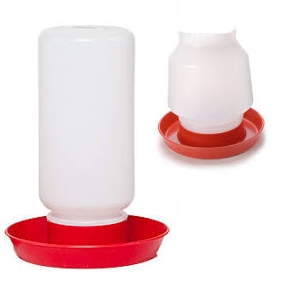 |
APPLICATION:
Watering chicks, ducklings, and poults. |
| DISCUSSION:
|
|
Filling and cleaning poultry waters can be a chore. Keeping
shavings and dirt out of the water pan can also be a challenge.
With poultry waters, I want something that will do the job with
the minimum amount of work. Criteria:
- Suitable for small chicks
- Easy of use
- Easy to clean
- Size suitable for brooders
- Durable
|
REVIEW:
 |
Old fashion is sometimes the best. When I was a child, we used these
types of waterers... the bottoms were made of galvanized sheet metal
and the jugs were common quart and gallon glass jars. They
functioned well then, and they continue to function well.
- Suitable for small chicks: Yes, the quart size is
perfect for chicks 0-4 days of age. Gallon size is perfect
for chicks 5+ days old.
- Easy of use: Yes, easy to fill and carry.
A small amount of spillage can occur when flipping the
waterer over. Care must be used in securely screwing the jug
on the gallon size else the unit might separate upon
flipping
- Easy to clean: Yes, cleaning the threads may
require a little effort but less so than other types of
waterers.
- Size suitable for brooders: Yes, I keep the quart
size for very small chicks and the gallon size for older
chicks..
- Durable: Yes, the plastic cracked on one waterer
over the past 8 years. All other units continue to be in
use.
|
| NEGATIVE POINTS: |
- Require constant refill
- Jug threads can harbor dirt
- Inside lip of quart jugs can be difficult to reach
|
| KEY FEATURES: |
- Easy to fill
- Easy to clean
- Easy to carry
|
| SPECIFICATIONS:
(from the
manufacturer) |
- Gravity-feed poultry waterer with 1-gallon or 1 quart capacity
- Durable transparent polyethylene so the water level is always visible
- Easy-fill screw-on design
- Jar and base may be sold as separate units
|
| |
PRICE & SOURCE: |
| |
|
Poultry
Drinker 1 Gallon
Harris Farm |
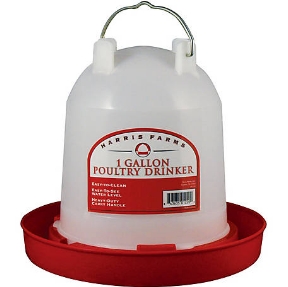 |
APPLICATION:
Watering chicks, ducklings, and poults. |
| DISCUSSION:
|
|
Filling and cleaning poultry waters can be a chore. Keeping
shavings and dirt out of the water pan can also be a challenge.
With poultry waters, I want something that will do the job with
the minimum amount of work. Criteria:
- Suitable for small chicks
- Easy of use
- Easy to clean
- Size suitable for brooders
- Durable
|
REVIEW:
 |
I have three of these and continue to use them; however, they are
only used for larger chicks and only when other chick waterers are
not available.
- Suitable for small chicks:
Problematic. Trough is too high for chicks to
reach over and too deep for chick safety.
- Easy of use: Yes, easy to fill and carry.
However, there is often spillage when placing the unit into
the brooder... any slight tilt will result in spillage.
- Easy to clean: Yes, cleaning the slots where the
top is connected to the base can be difficult and requires
special attention.
- Size suitable for brooders:
Problematic. The container is a little to
large and to tall for use in most of my brooding systems.
- Durable: Yes, all the ones I have purchased
continue to be in use.
PRODUCT IS NOT
RECOMMENDED |
| NEGATIVE POINTS: |
- Trough is too deep for hatchlings or small bantams
- Deep trough results in spillage while carrying
- Deep trough allows dirt/shavings to accumulate
|
| KEY FEATURES: |
- Easy to fill
- Easy to clean
- Easy to carry
|
| SPECIFICATIONS:
(from the
manufacturer) |
- Durable poly contains 50% more plastic than most competitors' products
- Features twist-lock system for easy setup without tools
- 5 qt. capacity
|
| |
PRICE & SOURCE: |
| |
|
Low Pressure Poultry Waterer
GQF Manufacturing |
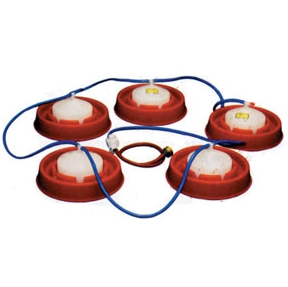 |
APPLICATION:
Watering chicks, ducklings, and poults. |
| DISCUSSION:
|
|
Filling and cleaning poultry waters can be a chore. Keeping
shavings and dirt out of the water pan can also be a challenge.
With poultry waters, I want something that will do the job with
the minimum amount of work. Criteria:
- Suitable for small chicks
- Easy of use
- Easy to clean
- Size suitable for brooders
- Durable
|
REVIEW:
 |
|
I installed four of these devices will virtually no problem and they
worked well for their intended purpose. One waterer would not shut
off the flow of water and attempts to correct the problem failed.
However, use was discontinued after a time because the unit could
not be easily disconnected from the water line, could not be
disassembled, and there was no easy means of cleaning under the
white hood. Traditional jug waterers were less trouble in the long
run.
PRODUCT IS NOT
RECOMMENDED
PRODUCT IS NO LONGER IN USE |
| NEGATIVE POINTS: |
- Product does not disassemble
- Difficult to disconnect from the low pressure line.
- No viable way of cleaning and disinfecting the area under
the white hood
|
| KEY FEATURES: |
- Pressure Reducing Valve
- 5 Feet of tubing
- Adjustable Water Level
- 9" Drinker
|
| SPECIFICATIONS:
(from the
manufacturer) |
- Requires low pressure water lines of about 8 lbs.
|
| |
PRICE & SOURCE: |
| |
|
Bird
Netting 25'x50'
Zeny Products |
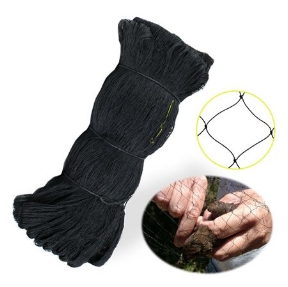
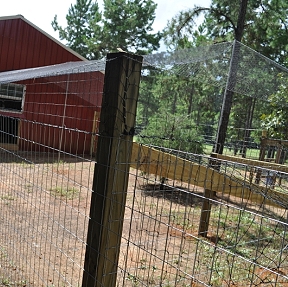 |
APPLICATION:
Top netting for flight pens & chicken runs |
| DISCUSSION:
|
|
Hawks, owls, and other predators can take a toll on a flock. Not
all birds like to stay at home and tend to wonder to the
neighbors or leave entirely. While I prefer to allow my birds to
free range as much as possible, there are several instances
where penning is the best solution. I use top netting for all
peafowl, grow-out pens, and selective breeding pens. Through
some trial and error, Zeny netting is the best fit for my
situation.
Criteria:
- Durable:
- Easy to Install:
- Weight Bearing:
- Looks Nice:
- Relative Inexpensive:
|
REVIEW:
 |
I'm cheap. The less it costs me to build a coop or pen, the more
birds I can afford to keep. For flight pens, I've developed a pole
and bracing wire method of construction that minimizes costs and
remains solid for several years. Zeny netting is inexpensive, but
effective. I've not yet found the need to replace it.
- Durable: Abrasion and chaffing will occur if the
netting rubs up against something persistently... such as a tree
trunk. I've also had some of the netting tear when I roughly
pulled small tree branches through it. But, with care, all
netting currently in use looks just as good as the day
installed.
- Easy to Install: The four corners are marked with
colored string for easy identification, the netting does not
become tangled easily, and it stretches well. Once the bracing
wire framework is constructed, it is fairly easy to stretch the
netting across the top. I use UV treated black mason string to
secure the netting to the side fencing. This weaving does take
an hour or two.
- Weight Bearing: I've had guineas and juvenile turkeys
walk across the top of the netting without damage to the
netting.
- Looks Nice: From a distance, the netting is not very
visible. Up close, the netting remains stretched without
sagging.
- Relative Inexpensive: $25 is cheaper than using other
materials - such as chicken wire - to cover flight pens and
runs.
NOTATION: Not all bird netting is
the same. I've ordered, received, and attempted to install
different brands of top netting. Some are thin, flimsy, and lack
marked corners. Zeny is the only brand that I would recommend. |
| NEGATIVE POINTS: |
- 2" mesh is too large for smaller birds such as quail
- Cord abrasion/chaffing occurs when constantly rubbed again
another surface
- String is thinner than more expensive bird netting
- Burst strength is not listed
|
| KEY FEATURES: |
- Inexpensive
- Ideal for birds, poultry, aviary, games, and pens
- Corners marked with colored string
- Lightweight and durable
- Knotted mesh prevents rips from enlarging
|
| SPECIFICATIONS:
(from the
manufacturer) |
- 25' x 50' bird netting.
- 2" black square mesh
- nylon multi-filament net that is UV resistant
- 5.6 pounds
|
| |
PRICE & SOURCE: |
| |
|
























